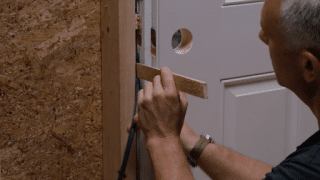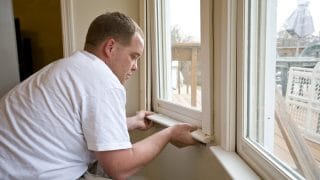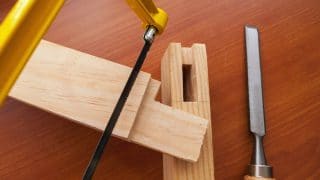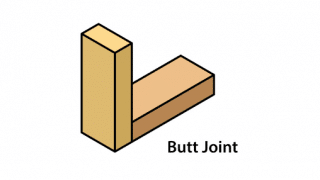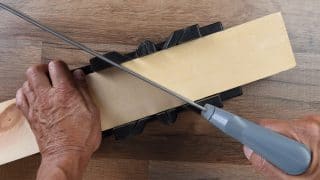
For elements that are not essential to the structures of houses, cabinets can be a remarkably important factor in shaping their look and feel, playing a starring role in kitchens and bathrooms and an often essential one in other rooms. Whether you are undertaking a bathroom remodel, building a new kitchen design from scratch, or assuring that a den or garage will be both beautiful and functional, it’s important to choose wisely among your cabinet options.
Knowing the range of materials and their pros and cons is key to creating cabinets that are both stylish and built to last. Here’s a look at the factors to consider when choosing materials for cabinet cases and cabinet doors.
Common materials for cabinet boxes
The term cabinet box, or cabinet case, refers to the encasement of the cabinet where functionality and durability matter most. For case construction, it is common to use engineered wood materials like plywoods, MDFs, and particle board.
Plywood
Plywood is a product constructed of thin layers of wood, with the grain of the alternating sheets perpendicular to each other. Plywood cabinets are resistant to the movement typically caused by the expansion and contraction that is common to solid wood. The alternating grains also make plywood better able to hold screws and fasteners for cabinet hardware.
MDF
Medium density fiberboard (MDF) is a wood-based product that is another popular choice for cabinet cases. It is made of fibers covered with thin veneers, and it has the advantage of being entirely flat and ready for paint. On the negative side, the fiber construction means that MDF doesn’t take fasteners well. If you use MDF, pre-drill holes for fasteners and add glue to the hole to assure fasteners stay in place.
Particle board
Particle board is made of wood chips, sawdust, and resin, but as cabinetmaker Ken DeCost warns, “These can become very brittle and break easily. When they get wet, they can swell and kind of crumble, and they’re loaded with formaldehyde.” For these reasons, many contractors prefer to use particleboard only for short-term, temporary structures.
Learn about the anatomy of cabinets, common materials, and the proper techniques to build quality pieces with cabinet maker Ken DeCost in MT Copeland’s Introduction to Cabinetry online course.
Common materials for cabinet doors
Some sheet goods that are not ideal for cabinet cases are better suited for cabinet doors or drawer fronts. For example, high-pressure laminates are often applied to MDF when they are used for cabinet doors, creating a product that is especially resistant to chemicals, fire, and wear.
Combi-core plywood
This engineered wood product has a particle-board core and MDF veneers. It is more expensive than MDF, but less expensive than plywood—a good option for laminate cabinets or when budget is a concern.
Plywood
If you are considering plywood for cabinet doors, concentrate on options with a fine wood veneer. While a D-grade plywood is adequate for some construction projects, when appearances matter—as they do with wood cabinets—you’ll want to opt for higher-end veneers. Look for those graded A1 and A2.
For elements that are not essential to the structures of houses, cabinets can be a remarkably important factor in shaping their look and feel, playing a starring role in kitchens and bathrooms and an often essential one in other rooms. Whether you are undertaking a bathroom remodel, building a new kitchen design from scratch, or assuring that a den or garage will be both beautiful and functional, it’s important to choose wisely among your cabinet options.
Knowing the range of materials and their pros and cons is key to creating cabinets that are both stylish and built to last. Here’s a look at the factors to consider when choosing materials for cabinet cases and cabinet doors.
Common materials for cabinet boxes
The term cabinet box, or cabinet case, refers to the encasement of the cabinet where functionality and durability matter most. For case construction, it is common to use engineered wood materials like plywoods, MDFs, and particle board.
Plywood
Plywood is a product constructed of thin layers of wood, with the grain of the alternating sheets perpendicular to each other. Plywood cabinets are resistant to the movement typically caused by the expansion and contraction that is common to solid wood. The alternating grains also make plywood better able to hold screws and fasteners for cabinet hardware.
MDF
Medium density fiberboard (MDF) is a wood-based product that is another popular choice for cabinet cases. It is made of fibers covered with thin veneers, and it has the advantage of being entirely flat and ready for paint. On the negative side, the fiber construction means that MDF doesn’t take fasteners well. If you use MDF, pre-drill holes for fasteners and add glue to the hole to assure fasteners stay in place.
Particle board
Particle board is made of wood chips, sawdust, and resin, but as cabinetmaker Ken DeCost warns, “These can become very brittle and break easily. When they get wet, they can swell and kind of crumble, and they’re loaded with formaldehyde.” For these reasons, many contractors prefer to use particleboard only for short-term, temporary structures.
Learn about the anatomy of cabinets, common materials, and the proper techniques to build quality pieces with cabinet maker Ken DeCost in MT Copeland’s Introduction to Cabinetry online course.
Common materials for cabinet doors
Some sheet goods that are not ideal for cabinet cases are better suited for cabinet doors or drawer fronts. For example, high-pressure laminates are often applied to MDF when they are used for cabinet doors, creating a product that is especially resistant to chemicals, fire, and wear.
Combi-core plywood
This engineered wood product has a particle-board core and MDF veneers. It is more expensive than MDF, but less expensive than plywood—a good option for laminate cabinets or when budget is a concern.
Plywood
If you are considering plywood for cabinet doors, concentrate on options with a fine wood veneer. While a D-grade plywood is adequate for some construction projects, when appearances matter—as they do with wood cabinets—you’ll want to opt for higher-end veneers. Look for those graded A1 and A2.
Hardwood
Solid hardwoods present a huge variety of choices when it comes to cost, appearance, and durability. Many hardwoods arrive from lumber yards in a rough sawn state, and it may be necessary to clean them up to get them to a more presentable appearance.
Stainless steel
Stainless steel is a popular choice for restaurant kitchens, and few materials compare when it comes to durability. Unlike wood it does not expand or contract—a quality that is especially appealing in very humid areas. On the downside, stainless steel can have a tendency to scratch and fingerprints are often stubbornly visible.
Aluminum frames
Aluminum frames with glass inserts have long been a popular option for kitchen cabinets in Europe. Increasingly, they are making inroads into the North American market. They are lightweight, easy to install, and customizable with a variety of different panel insert options.
Vinyl film
These affordable films can be applied over existing cabinet doors and come in a range of colors and grain patterns. It’s an inexpensive and fast route to a refreshed look if new cabinets are beyond your budget.
MT Copeland offers video-based online classes that give you a foundation in construction fundamentals with real-world applications, like building cabinets.
Classes include professionally produced videos taught by practicing craftspeople, and supplementary downloads like quizzes, blueprints, and other materials to help you master the skills.


